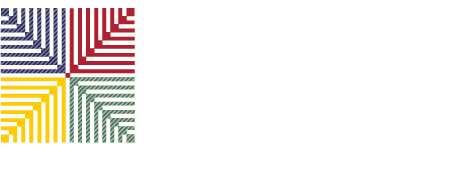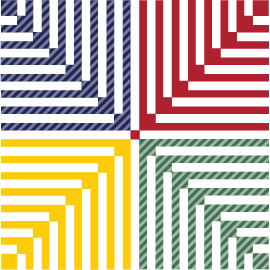

We had the opportunity to speak with Ghnaim this week as she prepares to come to Boston for BPFF’s Closing Celebration where she’ll join Palestinian embroidery artist Clotilde Abudi and other panelists to discuss Palestinian embroidery and its role in Palestinian culture and heritage.
BPFF: Where and when did you first learn the art of Palestinian embroidery? Who taught it to you?
WG: I was born in Brighton, Massachusetts, where my two sisters and I began learning Palestinian embroidery from my mother. My mother learned embroidery from her mother and grandmother. In Palestinian culture, tatreez embroidery is traditionally passed down from mother to daughter. I started learning embroidery at age 2. My older sister began when she was 4 years old.
Throughout my childhood, I traveled alongside my mother for exhibitions, lectures, and demonstrations around the US where she taught Palestinian embroidery, from folklore festivals in Cambridge, Massachusetts, to elementary schools in southeast Portland, Oregon. At first, I learned the waste canvas technique, which I detail in my book Tatreez & Tea: Embroidery and Storytelling in the Palestinian Diaspora. She would embroider, and my sisters and I would remove the waste canvas. This practice allowed me to analyze her stitches and style, and hear the stories she was sharing in each motif.
BPFF: How was Palestinian embroidery used historically?
WG: My knowledge of embroidery and how it’s used historically is one that I learned through my mother and grandmother, and not through history books or academia. I speak from a “knowing” that is ancestral and maternal. Tracing embroidery back to my great grandmother and grandmother, they practiced embroidery together, with their daughters, their friends, and their friends’ daughters. They would gather to embroider garments for one another and together, tell stories, and learn from one another.
When it comes to the motifs, Palestinian women historically used them to tell a story, teach or mark a historical event, or educate future generations. Each motif is a coded language used by Palestinian women to communicate to one another. In my great-grandmother and grandmother’s generations, they did not go to school to learn how to read or write. Embroidery was their way of writing down their feelings, observations, and experiences and ultimately having a voice.
BPFF: Does embroidery and its techniques reflect what is happening in Palestine (both historically and today)?
WG: The skill of producing embroidery by hand is being lost. It is an endangered art that Palestinians are no longer passing down to their children due to diaspora, exile, war, and occupation. Embroidery is absolutely a reflection of what is happening today in Palestine, in the sense that machine-made embroidery is replacing the handmade artistry of our maternal ancestors. My work in Tatreez & Tea is dedicated to teaching this art to the next generation so that this folk art can thrive and be alive in the Palestinian diaspora around the world.
BPFF: What is the significance of Palestinian embroidery as a means to preserve culture and illustrate narrative today?
WG: Many efforts in the last 30 years around preserving Palestinian embroidery have been made from a consumer’s perspective. Many books and much of the information available online about the origins of embroidery and significance, have been from a collector’s perspective. Tatreez embroidery is valued primarily for its aesthetics and from which village it is from. But this is not the total value of Palestinian embroidery, and is not a vehicle solely used to identify Palestinians with their home village.
Palestinian embroidery was and is a storytelling tool in the diaspora. We can retrace the stories of our grandmothers, and use the motifs to tell our stories. Also, it is a meditative art that can be practiced by all skill levels. You do not need to be a dressmaker to practice embroidery. You could make a scarf, wall hanging, pin, bookmark… Depending on your skill level, you can practice the traditional cross-stitch and succeed.
The significance of Palestinian embroidery as a means to preserve culture and illustrate narrative is through the color of the thread we select, the motif, stitches and fabric we use – each aspect of our work tells a part of our story. My mother always told me that she felt her stories were safe in tatreez. No one could distort or steal her stories, the way words could be distorted or stolen. Tatreez is a part of our identity that can never be occupied or stolen, as long as we understand the meaning and know how to keep this art alive.
BPFF: How is Palestinian embroidery woven into your daily life?
WG: Tatreez is home. When I am practicing embroidery, it is when I feel closest to my mother, closest to Palestine, closest to my childhood, closest to who I am before I entered into the world and became aware of prejudice and injustice. When I practice embroidery, it reminds me of who I am. Not just as a Palestinian, but as an artist. As a woman with history, identity, and compassion. In every stitch I cross, I am reminded of my ancestors who crossed their stitches in the same manner. So, the practice of embroidering is meditative and therapeutic. The repetition of the stitches, the vibrant colors of the thread and the fact that I am creating a motif stitch-by-stitch brings me peace and joy. These feelings drive me to practice embroidery in my daily life, and is why I have dedicated my life through Tatreez & Tea to pass this tradition on to the next generation.
BPFF: Are there any particular patterns or stitches that you use in your embroidery if so, why?
WG: The cross-stitch is the primary stitch used in Palestinian embroidery, in particular the embroidery of Safad where my mother and grandmother are from. With the cross-stitch, I love to integrate the Tree of Life, or otherwise known as the Cypress Tree motif, in my designs. It is representative of life, beauty, celebration, and connection to the land. It bears fruit, representing the cycle of life and sustenance. As a new mother, I connect deeply with the tree of life, and how it reflects aspects of reproduction and the cycle of life.
BPFF: What does Palestinian embroidery mean to you in three words?
WG: Home. Voice. Connection.
BPFF: What is Tatreez & Tea? What inspired you to make Palestinian embroidery your business/career?
WG: Tatreez & Tea is also the title of my digital book, soon to be printed, which was funded by the Brooklyn Arts Council, Regional Arts & Culture Council, and the Clackamas County Cultural Coalition in 2016. From the book, I created a nonprofit, fiscally sponsored by the Brooklyn Arts Council, whose mission is to provide educational resources, namely through workshops, lectures, and publications, to preserve Palestinian arts, crafts, and folkloric traditions in the diaspora community. Traditionally, Palestinian women created various crafts, predominantly embroidery, that told the stories of their lives. Today, personal narratives of the embroiderers are being lost due to our culture’s increasing aesthetic valuation and commercial appropriation of the art. My goal is to preserve, document, and share Palestinian artistry and storytelling traditions so they are no longer endangered.
My mother did this work when she first immigrated to this country in 1979 and has been working to do the same thing her entire life. She had been an art teacher by trade, but when she came to the US, she became a master of the folk art and has apprenticed many Palestinian women in the craft–including myself and my two sisters. She not only passed the tradition of embroidery down to me, but also the art of teaching embroidery to others.
BPFF: Tell us about the second edition of your book. What’s new, why are you coming out with a second edition?
WG: When I was funded to write the first edition of the book, I had 12 months to draft the manuscript, photograph images, edit, format, self-publish. It was a lot to do. I could only cover 27 patterns in the first edition, but there were many more motifs that were preserved and passed on in my family. The Brooklyn Arts Council and Clackamas County Cultural Coalition funded me a second year, in 2017, to add 10 to 15 more patterns to the book and write about their meanings. I will be adding important motifs, like the Tree of Life, Reesha (feather), floral motifs, motifs for men’s clothing and more. My primary focus in Tatreez & Tea, is to share their stories and meanings. These motifs tell a story, and most Palestinians do not know what those meanings are. All of our traditional motifs have a story, and it is my goal to share and preserve them in the Palestinian diaspora. Tatreez & Tea enables me to not only teach the cross-stitch, but to document the stories and meanings of the motifs and ensure they are kept alive for generations to come.
–Maura James for BPFF
If you’d like to meet Wafa Ghnaim, join us Saturday, October 28 at BPFF’s Closing Celebration. The event will also feature an extensive exhibit of embroidery by Palestinian artist Clotilde Abudi and guest panelists. Food from Aceituna Grill and Andala Café as well as Palestinian Taybeh beer and other drinks will be provided. Join us as we celebrate Palestinian embroidery and its impact on culture through time. Tickets: $15, available here. $20 at the door.
Our Closing Film, Stitching Palestine by Carol Mansour, profiles 12 Palestinian women who are linked by the thread of embroidery. Stitching Palestine screens on Sunday, October 29, 2017 at the Museum of Fine Arts, Boston at 3:00p and is co-presented with ANERA.
View the full festival schedule and buy tickets here.

